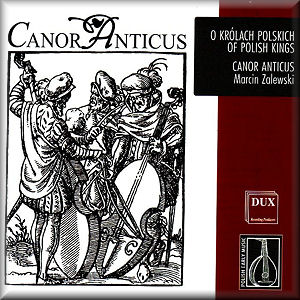 |
 |
|


alternatively
CD: MDT
AmazonUK
AmazonUS
|
O królach polskich - Of Polish Kings
Anon.
O królach polskich [Of Polish Kings] [01:14]
Seweryn KON
(?-?)
[piece without title] [01:15]
Duma [Elegy] [01:44]
Valentin BAKFARK (1507-1576)
Fantasia V [04:20]
Czarna krowa [Black cow] [02:37]
Fantasia VI [06:38]
Albo juz dalej trwac nie moge [No longer can I bear] [03:47]
Fantasia VII [07:48]
Valentin HAUSMANN (c.1565/70-c.1614)
Polnischer Tanz I [02:01]
Polnischer Tanz II [00:50]
Polnischer Tanz III [01:11]
Diomedes CATO (before 1570-after
1607)
Canzona Diomedis [01:36]
Anon.
Przez Twe swiete zmartwychwstanie [Through your holy resurrection]
[01:23]
Nasz Zbawiciel [Our Saviour] [01:59]
Nasz Zbawiciel Pan Bóg [God our Saviour] [01:52]
Nasz Zbawiciel [Our Saviour] [03:22]
Marcin Z WARTY (WARTECKI) (2nd half
16th C.)
Nos autem gloriari oportet (Introitus de S. Cruce) [02:26]
Jakub SÓWKA (SOWA) (?-1611)
Kyrie paschale [01:00]
Krzysztof KLABON (before 1550-after
1616)
Kyrie, Christe, Kyrie ultimum [03:33]
Piotr DRUSINSKI (?-1611)
Preambulum I [01:17]
Veni redemptor gentium [01:29]
Preambulum II [01:14]
Resonet in laudibus [01:52]
Anon.
O królach polskich [Of Polish Kings] [01:22]
 Canor Anticus (Marcin Zalewski, Aleksander Dlugajczyk, Wojciech
Zalewski, Maria Sarap, Kazimierz Gruszczynski, viola da gamba)/Marcin
Zalewski
Canor Anticus (Marcin Zalewski, Aleksander Dlugajczyk, Wojciech
Zalewski, Maria Sarap, Kazimierz Gruszczynski, viola da gamba)/Marcin
Zalewski
rec. December 1996 and January 1997, Grand Ballroom of Sapieha Palace,
Warsaw, Poland. DDD
 DUX 0761 [57:50]
DUX 0761 [57:50] 
|
|
|
The musical past of the countries of Central and Eastern Europe
is little known in other parts of the world. It seems only recently
that discs with Polish music of the renaissance and baroque
periods, performed by Polish ensembles, have reached the outside
world. In the last two years or so I have reviewed several discs
with Polish music which were originally recorded five years
or longer ago. That is also the case here: the recording dates
from 1997, but I had never heard of it nor of the ensemble before.
It has now been reissued by Dux and sent to MusicWeb International
to be reviewed.
There is one handicap in the research of the musical heritage
of Poland. During World War II many manuscripts have been destroyed
or have just disappeared, and as a result our knowledge of the
music of the 16th and 17th centuries is limited. A number of
pieces on this disc are also from manuscripts which are no longer
available. Fortunately some of them had been copied or microfilmed
before the war.
In the renaissance instruments were mainly used to support singers.
When purely instrumental music was performed, it mostly involved
transcriptions of vocal music or dance music. Many transcriptions
can be found in tablatures, in particular for organ. A large
number of pieces on this disc are taken from such sources. The
organ tablature of Jan of Lublin is a source regularly used
by organists. But there is no reason whatsoever not to play
these pieces on other instruments or, as here, with an instrumental
consort.
Consorts of instruments were very popular during the renaissance.
They could comprise various instruments: violins, viols, recorders
or cornetts and sackbuts. Musicians were practical in those
days: they played music on whatever instrument they had at their
disposal. In regard to consort music it was most common to play
on instruments of one family. Mixing wind and strings - viols
and recorders, for instance - was an exception.
This disc brings various kinds of music which were part of the
consort repertoire of those days. So there are some typically
instrumental forms - especially used for keyboard music -, like
the fantasia, the canzona and the praeambulum (or prelude).
In addition we hear dances (Haussmann) and transcriptions of
vocal pieces, including parts of the Mass. Many pieces are anonymous,
but even where a name has come down to us most lovers of renaissance
music probably won't have heard of them. The best-known composers
in the programme are Valentin Bakfark and Valentin Haussmann.
The former was a famous lutenist, born in Transylvania, and
working for a while at the royal court in Poland. The latter
was from southern Germany, and also spent some time in Poland.
The latest music dates from the first decade of the 17th century.
But at that time the new Italian concertante style hadn't reached
Poland.
I haven't always assessed recordings by Polish ensembles all
that positively. It is different this time: I have very much
enjoyed this disc. The five players of Canor Anticus give very
fine performances on their viols, ranging from treble to bass.
They produce a beautiful sound and the ensemble is excellent.
The players are not afraid to explore the full dynamic range
of their instruments. That is certainly right: there is no reason
why renaissance music should be played at more or less the same
dynamic level all the time. They shape the musical lines beautifully
and the various voices of these polyphonic pieces are clearly
discernable.
The repertoire is another reason why this disc is commendable:
even those who have a special interest in renaissance music
won't hear much they already knew. There is just one well-known
melody: the transcription of a setting of the hymn 'Resonet
in laudibus' by Drusinski.
Because of the quality of the music and the level of the performances
this disc is a winner, and a worthwhile addition to any record
collection.
Johan van Veen
|
|

